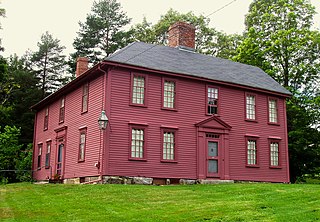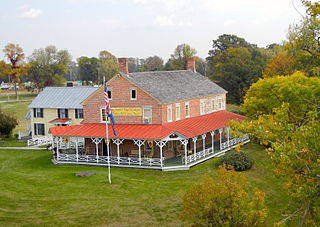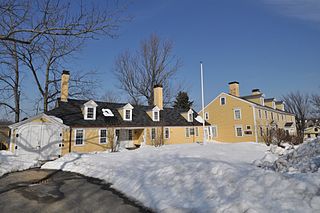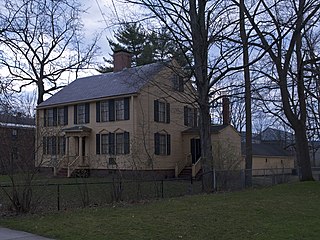
Fraunces Tavern is a museum and restaurant in New York City, situated at 54 Pearl Street at the corner of Broad Street in the Financial District of Lower Manhattan. The location played a prominent role in history before, during, and after the American Revolution. At various points in its history, Fraunces Tavern served as a headquarters for George Washington, a venue for peace negotiations with the British, and housing federal offices in the Early Republic.
Captain Jeremiah O'Brien (1744–1818) was an Irish-American captain in the Massachusetts State Navy. Prior to its existence, he commanded the sloop Unity when he captured the British armed schooner HMS Margaretta in the Battle of Machias, the first naval battle of the American Revolutionary War. He also led the first American attack on Nova Scotia in the Raid on St. John (1775).

Munroe Tavern, located at 1332 Massachusetts Avenue, Lexington, Massachusetts, is an American Revolutionary War site that played a prominent role in the Battle of Lexington and Concord. It is now preserved and operated as a museum by the Lexington Historical Society, with exhibits highlighting the role and perspective of the British soldiers during the outbreak of the war. The house is open for guided tours on weekends starting in April and daily from Memorial Day weekend until the end of October.

Buckman Tavern is a historic American Revolutionary War site associated with the revolution's very first battle, the 1775 Battle of Lexington and Concord. It is located on the Battle Green in Lexington, Massachusetts and operated as a museum by the Lexington Historical Society.

The Boston National Historical Park is an association of sites that showcase Boston's role in the American Revolution. It was designated a national park on October 1, 1974. Seven of the eight sites are connected by the Freedom Trail, a walking tour of downtown Boston. All eight properties are National Historic Landmarks.

Chimney Point is a peninsula in the town of Addison, Vermont, which juts into Lake Champlain forming a narrows. It is one of the earliest settled and most strategic sites in the Champlain Valley.

The Indian King Tavern was a colonial American tavern in Haddonfield, Camden County, New Jersey, United States, which was the site of a 1777 meeting of the New Jersey General Assembly that officially ratified the Declaration of Independence and adopted its Great Seal. It was the first State Historic Site, adopted as such in 1903. Its original structure remains largely intact. It is listed on the National Register of Historic Places.

The Tate House is a historic house museum at 1270 Westbrook Street, near the Fore River in the Stroudwater neighborhood of Portland, Maine, United States. The house, one of the oldest in Portland, was built in 1755 for George Tate, a former Royal Navy captain who was sent by a contractor to the Navy to oversee the felling and shipment of trees for use as masts. Because of the house's comparatively remote location away from central Portland, it survived Portland's numerous fires intact. The house was designated a National Historic Landmark as a rare surviving example of a once-common colonial housing form, the clerestory gambrel roof. Since 1935 it has been a museum operated by the National Society of the Colonial Dames.

Fort O'Brien State Historic Site, also known as Fort Machias, preserves the remains of a fort located in Machiasport, Maine that was built and destroyed three times over a 90-year period. It was involved in military actions during the American Revolutionary War and the War of 1812, and was listed on the National Register of Historic Places. It is now managed by the Maine Department of Conservation's Bureau of Parks and Lands, and is open between Memorial Day and Labor Day.

The Redington Museum or Redington House is a historic house and museum in Waterville, Maine that is listed on the National Register of Historic Places. The museum is the headquarters of the Waterville Historical Society. Built in 1814, it is one of the best-preserved houses of the period in the city. It has served since 1924 as the museum and headquarters of the Waterville Historical Society, and was listed on the National Register of Historic Places in 1978.

The American Independence Museum is a historic house museum located in Exeter, New Hampshire. Its 1-acre (0.40 ha) campus includes two buildings: the Ladd-Gilman House, a registered National Historic Landmark built in 1721 by Nathaniel Ladd, and the Folsom Tavern, listed on the New Hampshire State Register of Historic Places and built in 1775 by Colonel Samuel Folsom. The museum was opened in 1991 after a rare copy of the Declaration of Independence known as a Dunlap Broadside was found in the Ladd-Gilman house, 200 years after its arrival in Exeter. It is the centerpiece of the museum’s collection. The museum’s mission is “Connecting America’s Revolutionary past with the present.”

The Battle of Machias was an early naval engagement of the American Revolutionary War, also known as the Battle of the Margaretta, fought around the port of Machias, Maine.

Rodgers Tavern, also known as Stevenson's Tavern, is a historic hotel located at Perryville, Cecil County, Maryland, United States. It is a mid-18th-century, two-story stone structure with a basement. All rooms have corner fireplaces. It was frequently visited by George Washington between the years 1755 and 1798, when it was owned and operated as an inn and tavern by Colonel John Rodgers (1728–1791). He was the father of John Rodgers (1772–1838), U.S. naval officer. During the 1880s the house was divided into two halves, east and west.

Thompson's War was an early American Revolutionary War confrontation between Samuel Thompson's patriot militia and loyalists supported by HMS Canceaux. The confrontation ended without fatalities, but provoked the retaliatory Burning of Falmouth five months later. Falmouth is now known as Portland, Maine, but Maine was part of Massachusetts at the time.

The Wyman Tavern is a historic house, former tavern, and now a local history museum, at 339 Main Street in Keene, New Hampshire. Built in 1762 by Isaac Wyman, it also served as the muster ground for militia at the outbreak of the American Revolutionary War. In 1968 the property was acquired by a local non-profit, which leases it to the Cheshire County Historical Society for use as a museum. The building was listed on the National Register of Historic Places in 1972.

The Jonathan Barnes House is a historic house on North Street in Hillsborough, New Hampshire. Built about 1775, it is locally distinctive as one of only a few colonial-era houses, and is a well-preserved example of Georgian styling. It has also seen a number of socially significant uses, serving at times as a tavern, library, music school, and fraternal lodge. Surviving interior architectural details provide a significant view into the history of tavern architecture. The house was listed on the National Register of Historic Places in 1982.

Fort Foster was a military site of the American Revolutionary War in what is now East Machias, Maine. Little more than a large earthworks, it was located on The Rim, a neck of land that commands the confluence of the Machias and East Machias Rivers. The earthworks were built in 1776, and attacked by British forces in the 1777 Battle of Machias. The site was listed on the National Register of Historic Places in 1973.

Machias is a town in and the county seat of Washington County in downeast Maine, United States.As of the 2010 census, the town population was 2,221. It is home to the University of Maine at Machias and Machias Valley Airport, a small public airport owned by the town.The word Machias roughly translates in Passamaquoddy as "bad little falls", a reference to the Machias River. Machias is best known as the site of the first naval battle of the American Revolution.

The Elkins Tavern is a historic house on Bayley-Hazen Road in Peacham, Vermont. Built in 1787 by one of Peacham's first settlers, it has one of the best-preserved 18th-century interiors in the state of Vermont. It was listed on the National Register of Historic Places in 1978.

The Raid on St. John took place on 27 August 1775 during the American Revolutionary War. The raid involved American privateers from Machias, Maine attacking St. John, Nova Scotia. The privateers intended to stop the export of supplies being sent to the loyalists in Boston. This raid was the first hostile act committed against Nova Scotia and it resulted in raising the militia across the colony.






















